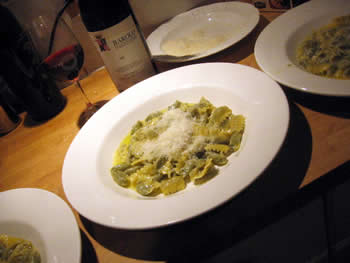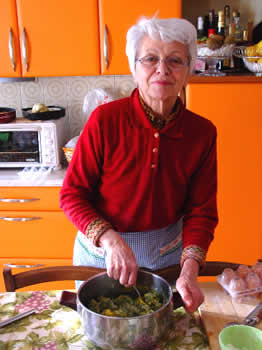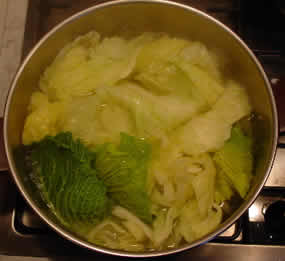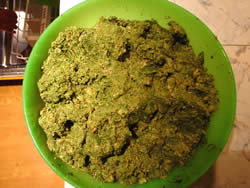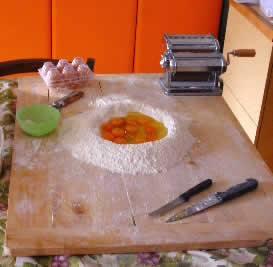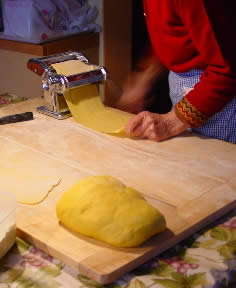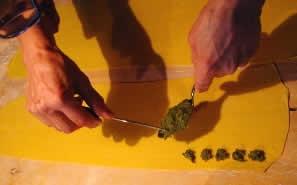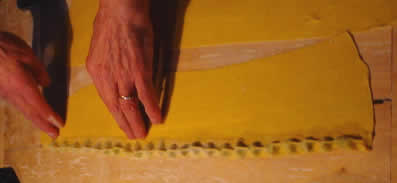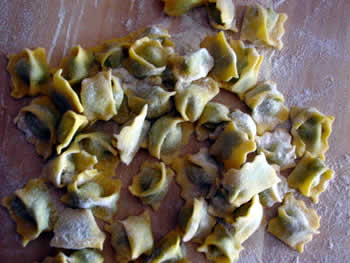
Agnolotti al plin - a masterclass
Agnolotti al plin
Perno, Le Langhe, Italy November 11, 2006 Our great winemaker friend Mario Fontana has entertained us often at his Cascina Fontana winery and home at Perno, high in the Barolo hills of Le Langhe. Mario's mother Elda is a truly wonderful cook who still knows how faithfully to prepare the traditional foods of Le Langhe. Here she gives us a masterclass in how to prepare handmade agnolotti al plin - the tiny stuffed ravioli that are the speciality of the region. The recipe may seem rather complicated and fiddly, but it isn't. It is time consuming and laborious, though, as are most great traditional foods. However, many hands make light work, as the saying goes, so get together with friends, open a bottle or two of Cascina Fontana wines, and have an agnolotti al plin party!
Mario's mother Elda
Ingredients
For the stuffing
200 g escarole or spinach
200 g cabbage
200 g carrots
Olive oil
1 clove garlic
Olive oil
1/2 kg veal
1/2 kg pork
Half a chicken breast
2 carrots
1 stick celery
1 clove garlic
Handful of fresh rosemary
100 g cooked ham
50 g mortadella
2 eggs
5 or 6 heaping tablespoons of grated parmigiano reggiano cheese
Grating of fresh nutmeg
Salt
2 whole eggs, beatenFor the pasta
10-11 eggs
About 1 kg flour (in general the measurement is 1 egg for every 100 g of flour – some cooks measure an egg to a fistful of flour – but of course the precise proportions depend on the size of eggs, the moisture content of the flour and other such variables)
Pinch of salt
A spoonful or two of olive oil
Water if necessary.To serve
200 g unsalted butter
Handful of fresh sage leaves
Plenty of grated parmigiano reggiano cheese
MethodFirst make the stuffing. Add the escarole or spinach, cabbage and carrots to a pot of boiling water and cook until tender. Drain and then sautée in a frying with olive oil and a chopped clove of garlic. Set aside.
Vegetables for the ripieno
In a separate heavy-bottomed cast-iron or earthenware pot, add some olive oil, then brown the pieces of veal, pork and chicken breast. Add the 2 carrots, a stick of celery, a clove of garlic and a sprig of rosemary. Add the white wine, bring to the boil, then cover tightly and reduce to a bare simmer. Cook until the meat is tender and falling apart, adding more liquid if necessary.
Cooking the meats
Finally chop the sautéed vegetables and meat all together, adding a little of the cooking liquid from the meats, as well as the cooked ham and mortadella.The result should be a soft filling that you can use to stuff the agnolotti. Just before filling, add the beaten eggs, grated parmigiano reggiano, freshly grated nutmeg and salt to taste.
The ripieno
Now make the pasta. You can make this either by hand, or in a food processor (our method). Depending on the size of your food processor, add the flour and the eggs in batches if necessary. Or else place the flour on a large board, make a well, and add the eggs. Add a spoonful or two of extra-virgin olive oil, a little water if necessary, and a pinch of salt. Mix well to form a dough that is soft but consistent. Knead well, then leave to rest at room temperature for about an hour.
Making fresh pasta
Next roll out the pasta to the second finest setting on your pasta machine.
Pasta machines make the job easier though some cooks still prefer to roll by hand
Lay out the sheets of rolled pasta. Using a spoon and a knife, add small amounts of the filling all along the length of each sheet of pasta.
Filling the agnolotti
Fold the pasta over the filling carefully in order to cover all the filling. Then, and this is the critical part!, squeeze the space between each raviolo using your thumb and index fingers as if you were giving the pasta a 'pinch' (in Piedmontese dialect they say 'plin' and this gives the name agnolotti or ravioli 'al plin').
Folding and pinching 'al plin'
Cut along the strip of now-stuffed pasta, then cut between each single agnolotto to separate.
Cutting the agnolotti
The finished agnolotti
Put the cut agnolotti on a large floured platter and make sure there is plenty of space so they don't stick together.
All that is left now is to cook the agnolotti when ready to eat. Bring a large pot of water to the boil, add salt, then add the agnolotti. They will cook in only the briefest time, just a minute or two (when they rise to the surface, they are done).
The agnolotti al plin can be served 'in brodo' that is, in a rich homemade chicken or beef broth, or else they can be bathed in melted butter and fresh sage, topped with grated parmigiano reggiano. For the Club Vino visit to Cascina Fontana, we enjoyed this exquisite dish topped with shavings of fresh summer truffles - tartufi estivi. Another way to enjoy the agnolotti is served with a meat ragù.
As the above steps demonstrate, making agnolotti is a time consuming affair, so Elda advises that it is best done with a group of friends, perhaps a day or two in advance of an important meal.
An agnolotti al plin party anyone?
Suggested wine: Cascina Fontana Barbera d'Alba - nothing else will do!
![]()
|Home| |QP New Media| |Kim's Gallery|
Copyright © Marc and Kim Millon 1997-2006
![]()

